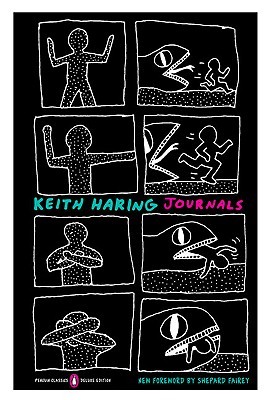"Journals" by Keith Haring
 I have to admit that I was never a huge fan of Keith Haring’s work. He was insanely popular during the 1980s but at the time, to be honest, I just didn’t “get it”. My first exposure to his work was not in a gallery or a museum, but in the subways of New York City. It wasn’t uncommon in those days to find any number of his drawings on the black paper which used to cover the old movie adverts or whatever other advertising one normally doesn’t pay that much attention to during the course of their commute. In those days, I worked as a messenger, so I was riding the subways all the time. Seeing Haring’s drawings was commonplace, as common as the ads themselves. It was only as the years went on — and as Haring became more of a popular visual artist — that I learned just who was behind these mysterious drawings, which in a way, at least to me, reminded me of glyphs from some long lost culture. Some of them were amusing, I admit, but his work never moved me as much as other artist’s work had. I know this is probably blasphemy in some quarters but it is what it is.
I have to admit that I was never a huge fan of Keith Haring’s work. He was insanely popular during the 1980s but at the time, to be honest, I just didn’t “get it”. My first exposure to his work was not in a gallery or a museum, but in the subways of New York City. It wasn’t uncommon in those days to find any number of his drawings on the black paper which used to cover the old movie adverts or whatever other advertising one normally doesn’t pay that much attention to during the course of their commute. In those days, I worked as a messenger, so I was riding the subways all the time. Seeing Haring’s drawings was commonplace, as common as the ads themselves. It was only as the years went on — and as Haring became more of a popular visual artist — that I learned just who was behind these mysterious drawings, which in a way, at least to me, reminded me of glyphs from some long lost culture. Some of them were amusing, I admit, but his work never moved me as much as other artist’s work had. I know this is probably blasphemy in some quarters but it is what it is.
The early 1980s was a very exciting time for me. There was a lot going on in New York City in those years and it was a very inspiring time. Everything was changing and I felt as thought I was right in the thick of it to some degree. At any given day there was some pop up gallery, some underground literary event, the “secretive”, word of mouth punk rock clubs, the “No Wave” scene, and of course the ‘club scene’, which I had nothing to do with nor wanted to. Besides, in the early 1980s, I was much too young to participate in many things and those places I did get into, checking IDs wasn’t common.
Reading Keith Haring’s “Journals”, I was hoping it would reveal a more detailed, in depth account of artistic life and the New York art scene in general, during these years. While they do to some extent, for the most part Haring’s journals reveals the innermost thoughts of an artist who took his work very seriously and for that alone you have to admire him. My view of his work went from being “just drawings I used to see in the subway” to a much deeper appreciation for what he actually accomplished. We are privy to his ideas, his aspirations, his influences, his motivations, and most importantly, what he had expected of himself as an artist. We also get a peek into his struggle with AIDS, which was unfortunately all too common among the downtown art scene in those days.
The journals also reveal some interesting insights into his ideas on “success” and “fame”. Early on in his career, as he became more popular and more in demand, he was asked how “success had changed him”. His response: “Success hasn’t changed me; it has changed people’s reaction to me”, something I found very interesting because of the truth it ultimately reveals. Haring’s work hadn’t changed much from his earliest days as a SVA student to when being commissioned by everyone and anyone for work. And as his social circle expanded to include the most prominent artists of the day, his work still remained HIS. However, as much as he tried to remain “unchanged” by his success, it was clear that it HAD changed him in a much more significant way: his travels, his social circle, which had begun to include celebrities, his feelings and opinions on his contemporaries (there’s a particular passage where he shows absolutely NO LOVE for his contemporary JULIAN SCHNABEL).
The book is a wonderful insight into the mind of an artist as he rises from student to world famous, celebrated artist. The same is that his life was cut short so soon. For admirers of Haring’s work, this is a must read. For those who may not have heard of him (the younger generation) or for those who never appreciated his work at the time (like me), it is a fascinating read which will cause you to reevaluate your opinions on who he was and what he had tried to accomplish. For the artist in general, there are some interesting insights here as well, as you watch the artist grow before you the further along you read.



